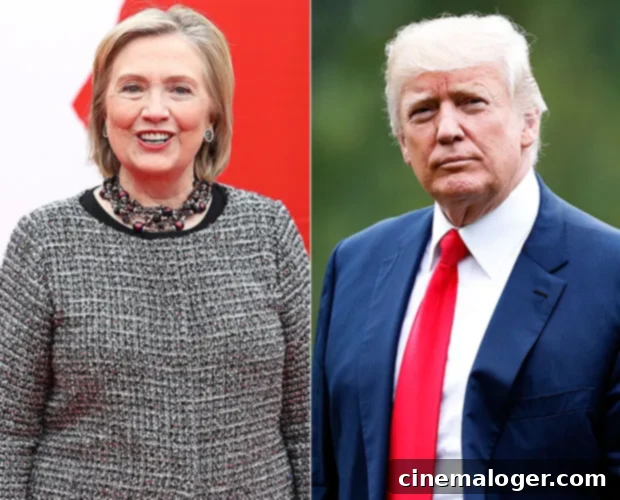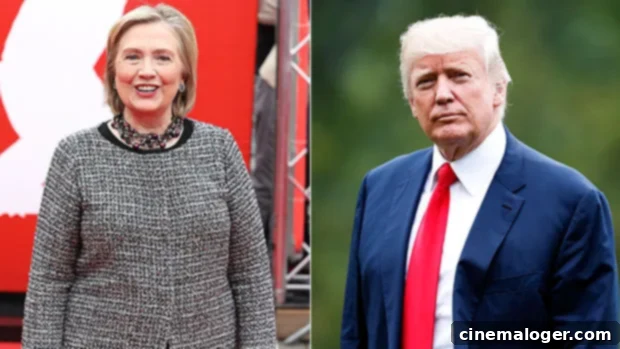Hillary Clinton’s Waving Emoji: A Symbolic Farewell to Donald Trump’s Atlantic City Legacy and Trump Plaza Demolition
In a masterful display of political commentary and succinct digital communication, Hillary Clinton delivered a potent message to her long-time political rival, Donald Trump, on February 17. Her chosen medium? A single, unambiguous waving-hand emoji. This simple gesture served as a powerful, grinning farewell to The Trump Plaza Hotel and Casino, which had just been spectacularly demolished in Atlantic City, New Jersey, that Wednesday morning. The former Secretary of State didn’t mince words, or rather, emojis, as she replied to a video of the wreckage shared via Bloomberg on Twitter. While the waving-hand emoji typically conveys a polite “hello” or “goodbye,” Clinton’s strategic deployment of the icon unequivocally symbolized a triumphant, albeit silent, send-off to what was once a prominent, albeit troubled, fixture of Donald Trump’s real estate empire.
👋 https://t.co/9WxAoipjtQ
— Hillary Clinton (@HillaryClinton) February 17, 2021
The immediate viral spread of Hillary Clinton’s tweet underscored the enduring fascination with the rivalry between these two formidable political figures. Her use of a simple emoji resonated across social media platforms, drawing both applause from her supporters and predictable outrage from Trump’s base. It wasn’t just a reaction to a building’s physical demise; it was a deeply symbolic act, reflecting years of political animosity, public scrutiny, and deeply personal clashes that defined a significant era of American politics. The demolition of Trump Plaza, for many, marked the end of an era, and Clinton’s emoji served as a poignant, and for her, satisfying, digital exclamation mark.
The Demise of Trump Plaza: A Fading Symbol of a Tumultuous Legacy
To fully appreciate the weight and political nuance of Hillary Clinton’s digital send-off, one must understand the comprehensive history and symbolism embedded in the Trump Plaza Hotel and Casino. Opened in 1984 on the iconic Atlantic City Boardwalk, Trump Plaza was, for a considerable period, considered a crown jewel in Donald Trump’s burgeoning real estate and casino portfolio. It was initially marketed as a luxurious destination, a beacon of opulence in the East Coast’s gambling capital. The casino hosted high-profile events, including legendary boxing matches featuring Mike Tyson, and epitomized the excess and ambition associated with Trump’s brand during the vibrant economic boom of the 1980s and 90s. For years, it stood as a tangible testament to his entrepreneurial spirit and his bold, aggressive entry into the highly competitive Atlantic City gambling market.
However, the initial glitz and glamour of Trump Plaza were eventually overshadowed by persistent financial woes and mounting management issues. Like many of Donald Trump’s casino ventures in Atlantic City, Trump Plaza faced a series of devastating bankruptcies, struggling repeatedly to maintain profitability amidst mounting debt, intense competition from rival casinos, and changing market dynamics. Its decline was gradual but ultimately relentless, transforming what was once a symbol of success into a visible indicator of economic downturns and the profound challenges faced by the once-thriving resort city. By 2014, the casino had finally ceased all operations, leaving behind a decaying, abandoned structure that quickly became an embarrassing blight on the Atlantic City skyline. For six long years, the derelict building loomed large, a concrete reminder of past grandeur and subsequent, undeniable failure.
The ultimate decision to demolish Trump Plaza was made in 2020, with funds notably provided by billionaire Carl Icahn, who had taken ownership of the property in its final years. The demolition itself became a highly publicized spectacle, attracting crowds of onlookers and extensive media attention from across the nation. On that crisp February morning, carefully placed explosives brought down the towering structure in a dramatic cloud of dust and debris, transforming a once-vibrant landmark into nothing more than rubble. This meticulously controlled act of destruction was far more than just the removal of an unsafe building; it was widely interpreted as the physical manifestation of the end of Trump’s direct, tangible legacy in Atlantic City – a legacy that, much like his political career, was characterized by both grand ambition and significant, often contentious, controversy.
A Deep-Rooted Political Feud: Hillary Clinton’s Unwavering Opposition to Donald Trump
Hillary Clinton’s, 73, long-standing disdain for Donald Trump, 74, is not merely a matter of differing political ideologies; it’s a well-documented saga woven into the very fabric of modern American politics. This rivalry became particularly intensified during their tumultuous 2016 presidential campaigns for the White House, an election cycle that was marked by unprecedented levels of personal attacks, profound policy disagreements, and a stark ideological divide that left an indelible, polarizing mark on the nation and its political landscape.
Even after her surprising defeat in the 2016 election, Hillary Clinton remained an exceptionally vocal and consistent critic of Trump’s presidency. Ahead of Trump ultimately losing the 2020 presidential election to President Joe Biden, Clinton made it unequivocally clear that she would spare no effort to “retire” Donald Trump from his position as leader of the free world. Her public statements, interviews, and social media activity consistently reflected this unwavering commitment, framing the 2020 election as an absolutely pivotal moment for the country’s future and its democratic institutions.
“But to be serious, the number one priority for our country and world is retiring Trump, and, as I always have, I will do whatever I can to support our nominee,” she tweeted in January 2020, signaling her profound dedication to the Democratic party’s efforts to unseat the incumbent president. This sentiment was powerfully reiterated later that year in November, when she spoke candidly with Amy Schumer in a revealing Zoom interview, stating, “I’m spending most of my time trying to do everything I can to retire [Trump], and to send him back to the golf course full-time.” These remarks highlight not just a strategic political objective, but a deeply personal resolve to see Trump out of office, reflecting years of intense political sparring and profound ideological opposition that extended well beyond policy disagreements.

On April 28, 2020, consistent with her stated intentions and deep concern for the nation’s direction, the former New York Senator formally endorsed Joe Biden for president on Twitter. Her endorsement was not just a formality of party unity; it was accompanied by a direct and sharp critique of the Trump administration, especially concerning its widely criticized handling of the emerging global pandemic. “Wish we had @JoeBiden‘s leadership in the Oval Office right now,” she wrote, emphasizing that “Americans deserve a president who will manage the COVID-19 crisis with the compassion, competence, and respect for science we need to save lives and revive the economy.” This strong statement underscored her profound belief that Biden possessed the essential qualities necessary to navigate the unprecedented challenges facing the nation, in stark contrast to her scathing assessment of Trump’s leadership and its perceived deficiencies.
Hillary Clinton’s endorsement and active campaigning for Joe Biden were part of a broader, unified, and highly coordinated effort by the Democratic Party to rally widespread support against the incumbent president. Her dedication, alongside countless other figures and grassroots activists across the campaign trail, was instrumental in shaping public opinion, mobilizing voters, and communicating the party’s vision. The cumulative impact of these efforts sought to underscore the urgency of the election and present a clear, compelling alternative vision for the country. Her involvement was a testament to her enduring influence within the Democratic party and her unwavering, long-term commitment to its political objectives.
The 2020 Election: A New Chapter and a Call for Unity
The culmination of these intense political battles and years of sustained opposition arrived decisively on November 7, 2020, when the results of the presidential election finally confirmed Joe Biden’s hard-fought victory. For many Americans, including Hillary Clinton and a vast number of her supporters, this marked the long-awaited and highly anticipated end of the “Trump-era” in the Oval Office. The election itself was historic in numerous ways, conducted amidst a raging global pandemic, significant social unrest, and unprecedented levels of political polarization that deeply divided the nation. Despite the challenges, it saw record voter turnout, reflecting the deep engagement and passionate convictions of the American populace regarding the country’s future direction.
Following his hard-fought victory, President-elect Biden, 78, delivered a message of reconciliation, hope, and national healing. In a powerful and widely acclaimed statement, he shared, “I am honored and humbled by the trust the American people have placed in me and Vice President-elect [Kamala]Harris. In the face of unprecedented obstacles, a record number of Americans voted. Proving once again, that democracy beats deep in the heart of America. With the campaign over, it’s time to put the anger and harsh rhetoric behind us and come together as a nation,” he said, declaring, “It’s time for America to unite. And to heal. We are the United States of America. And there’s nothing we can’t do, if we do it together.” Biden’s words offered a poignant vision of a unified nation, seeking to bridge the deep divides that had grown and festered over the preceding years, and to move forward with a renewed focus on healing, empathy, and collective action for the common good.
The transition of power, though not entirely without its challenges and lingering political tensions, ultimately marked a significant and undeniable shift in the nation’s political landscape. For those who had worked tirelessly to secure Trump’s departure from the White House, including Hillary Clinton, Biden’s victory represented the successful culmination of years of advocacy, strategic campaigning, and profound civic engagement. The symbolic end of Trump’s physical legacy in Atlantic City, coinciding so closely with his political departure from Washington, provided a powerful, almost poetic, parallel that was clearly not lost on Clinton or her followers, adding another layer of meaning to her simple, yet impactful, emoji.
The Lasting Resonance of a Simple Emoji
Hillary Clinton’s simple waving-hand emoji, sent in direct response to the spectacular demolition of Trump Plaza, transcends a mere social media post. It stands as a succinct, yet profoundly resonant piece of political communication, embodying years of a contentious rivalry and signaling a perceived, satisfying end of an era for many. In an age where digital gestures, memes, and emojis often carry immense cultural and political weight, Clinton’s emoji was a masterclass in brevity and strategic impact, delivering a message that was crystal clear to supporters and adversaries alike, without uttering a single word.
The incident perfectly encapsulates the complex and often dramatic dynamic between two towering figures who have dominated American political discourse for decades. For Hillary Clinton, it was an undeniable opportunity to acknowledge, with an unmistakable hint of satisfaction and perhaps relief, the literal and figurative dismantling of a prominent symbol associated with her political nemesis. For observers across the political spectrum, it offered a fleeting but potent moment of shared understanding, a collective nod to the long and winding, often acrimonious, road of their public feud and the shifting tides of American power.
Ultimately, the demolition of Trump Plaza and Hillary Clinton’s iconic emoji serve as more than just transient news items from a particular day in February 2021. They represent significant cultural and political markers, reflecting broader, enduring themes of legacy, political change, and the powerful, sometimes subtle, ways in which public figures engage with their pasts, their rivals, and the unfolding narrative of contemporary history. It was a digital gesture that, despite its simplicity, spoke volumes, echoing through the halls of political memory and underscoring the profound and enduring power of symbolism in shaping our collective understanding of political sagas and their often dramatic conclusions.
